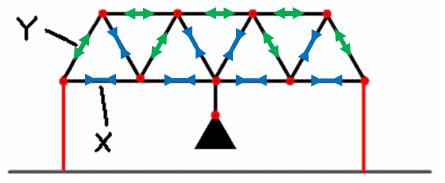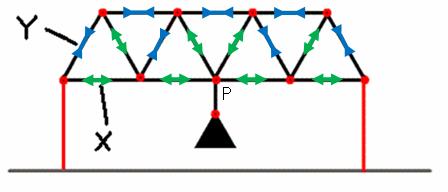Skip over navigation
Andre from Tudor Vianu National College, Bucharest, Romania produced a good solution to this question. Can you build on these ideas to answer the extension parts of the question?
The net force on the horizontal axis must be zero at each pin joint, so the projections of the forces on X and Y on the horizontal axis must have opposite directions. So, even if we do not know their magnitude we can still determine whether they are in compression or in tension.
If X is under tension then we must have:

The forces must be symmetrical in respect to a vertical axis which passes through the central weight. Starting from the left toward the centre, I obtained the following type of forces throughout the framework:

For the second part, a similar analysis shows that the structure must be as follows:

There would be a net downward force at P, so the equilibrium would not be stable.



Or search by topic
Number and algebra
Geometry and measure
Probability and statistics
Working mathematically
Advanced mathematics
For younger learners
Bridge Builder
Age 16 to 18
Challenge Level 





- Problem
- Getting Started
- Student Solutions
- Teachers' Resources
Andre from Tudor Vianu National College, Bucharest, Romania produced a good solution to this question. Can you build on these ideas to answer the extension parts of the question?
The net force on the horizontal axis must be zero at each pin joint, so the projections of the forces on X and Y on the horizontal axis must have opposite directions. So, even if we do not know their magnitude we can still determine whether they are in compression or in tension.
If X is under tension then we must have:
The forces must be symmetrical in respect to a vertical axis which passes through the central weight. Starting from the left toward the centre, I obtained the following type of forces throughout the framework:
For the second part, a similar analysis shows that the structure must be as follows:
There would be a net downward force at P, so the equilibrium would not be stable.
You may also like
Lunar Leaper
Gravity on the Moon is about 1/6th that on the Earth. A pole-vaulter 2 metres tall can clear a 5 metres pole on the Earth. How high a pole could he clear on the Moon?
Wobbler
A cone is glued to a hemisphere. When you place it on a table in what position does it come to rest?
More Bridge Building
Which parts of these framework bridges are in tension and which parts are in compression?

